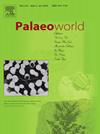中国陕西南部新发现的埃迪卡拉管状化石
IF 1.7
3区 地球科学
Q2 PALEONTOLOGY
引用次数: 0
摘要
古生物学对生物矿化的研究主要集中在研究寒武纪生物矿化动物的辐射。在寒武纪生物矿化演化辐射之前,大约 550-539 Ma 的埃迪卡拉晚期出现了弱生物矿化动物。在此,我们报告了中国陕西省南部宁强地区李家沟地段埃迪卡拉纪登封地层上部的许多新管状化石,包括两个新属和新种,即n. gen.首次发现的埃迪卡拉管状化石外表面的钻孔与Ⅳ类化石的钻孔相似,这可能揭示了最早的捕食者与被捕食者之间的动态关系。在埃迪卡拉管化石内壁上发现的小而精致的钻孔被推断为寄生虫出没的痕迹。本文章由计算机程序翻译,如有差异,请以英文原文为准。
New Ediacaran tubular fossils from southern Shaanxi, China
Much palaeontology research on biomineralization has been directed to studying the Cambrian radiation of biomineralizing animals. The evolutionary radiation of biomineralization in the Cambrian Period was preceded by weakly biomineralized animals in the late Ediacaran period around 550–539 Ma. Here we report many new tubular fossils from the upper part of the Ediacaran Dengying Formation in the Lijiagou section, Ningqiang area, southern Shaanxi Province, China, consisting of two new genera and species, namely Shufangtubulus inornatus n. gen. n. sp., and Palaeorhopalon spiniferum n. gen. n. sp. The newly discovered materials expand the list of the Ediacaran tubular fossils. The borings first found on the outer surface of Sinotubulites baimatuoensis are similar to those of Cloudina, which may reveal the earliest predator-prey dynamics. The small and delicate drill holes detected on the inner walls of Sinotubulites baimatuoensis are inferred to be infested traces by parasitism.
求助全文
通过发布文献求助,成功后即可免费获取论文全文。
去求助
来源期刊

Palaeoworld
PALEONTOLOGY-
CiteScore
4.00
自引率
5.90%
发文量
95
期刊介绍:
Palaeoworld is a peer-reviewed quarterly journal dedicated to the study of past life and its environment. We encourage submission of original manuscripts on all aspects of palaeontology and stratigraphy, comparisons of regional and global data in time and space, and results generated by interdisciplinary investigations in related fields. Some issues will be devoted entirely to a special theme whereas others will be composed of contributed articles. Palaeoworld is dedicated to serving a broad spectrum of geoscientists and palaeobiologists as well as serving as a resource for students in fields as diverse as palaeobiology, evolutionary biology, taxonomy and phylogeny, geobiology, historical geology, and palaeoenvironment.
Palaeoworld publishes original articles in the following areas:
•Phylogeny and taxonomic studies of all fossil groups
•Biostratigraphy, chemostratigraphy, chronostratigraphy
•Palaeoecology, palaeoenvironment and global changes throughout Earth history
•Tempo and mode of biological evolution
•Biological events in Earth history (e.g., extinctions, radiations)
•Ecosystem evolution
•Geobiology and molecular palaeobiology
•Palaeontological and stratigraphic methods
•Interdisciplinary studies focusing on fossils and strata
 求助内容:
求助内容: 应助结果提醒方式:
应助结果提醒方式:


